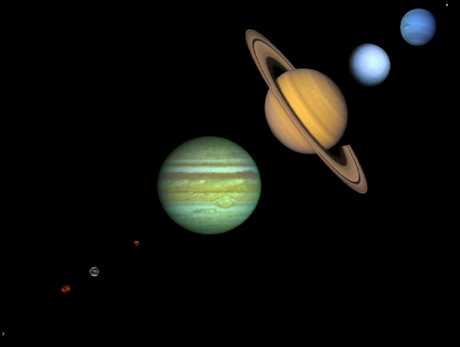
The solar system consists of the Sun; the nine planets, sixty four (64) satellites of the planets, a large number of small bodies (the comets and asteroids), and the interplanetary medium. The inner solar system contains the Sun, Mercury, Venus, Earth and Mars:

The planets of the outer solar system are Jupiter, Saturn, Uranus, Neptune and Pluto:

The orbits of the planets are ellipses with the Sun at one focus, though all except Mercury and Pluto are very nearly circular. The orbits of the planets are all more or less in the same plane (called the ecliptic and defined by the plane of the Earth's orbit). The ecliptic is inclined only 7 degrees from the plane of the Sun's equator. Pluto's orbit deviates the most from the plane of the ecliptic with an inclination of 17 degrees. The above diagrams show the relative sizes of the orbits of the nine planets from a perspective somewhat above the ecliptic (hence their non-circular appearance). They all orbit in the same direction (counter-clockwise looking down from above the Sun's north pole); all but Venus and Uranus also rotate in that same sense.
(The above diagrams show correct positions for October 1996.)

The above composite shows the nine planets with approximately correct relative sizes.
One way to help visualize the relative sizes in the solar system is to imagine a model in which it is reduced in size by a factor of a billion (1e9). Then the Earth is about 1.3 cm in diameter (the size of a grape). The Moon orbits about a foot away. The Sun is 1.5 meters in diameter (about the height of a man) and 150 meters (about a city block) from the Earth. Jupiter is 15 cm in diameter (the size of a large grapefruit) and 5 blocks away from the Sun. Saturn (the size of an orange) is 10 blocks away; Uranus and Neptune (lemons) are 20 and 30 blocks away. A human on this scale is the size of an atom; the nearest star would be over 40000 km away.
Not shown in the above illustrations are the numerous smaller bodies that inhabit the solar system: the satellites of the planets; the large number of asteroids (small rocky bodies) orbiting the Sun, mostly between Mars and Jupiter but also elsewhere; and the comets (small icy bodies) which come and go from the inner parts of the solar system in highly elongated orbits and at random orientations to the ecliptic.
The classification of these objects is a matter of minor controversy. Traditionally, the solar system has been divided into planets (the big bodies orbiting the Sun), their satellites (a.k.a. moons, variously sized objects orbiting the planets), asteroids (small dense objects orbiting the Sun) and comets (small icy objects with highly eccentric orbits). Unfortunately, the solar system has been found to be more complicated than this would suggest:
The nine bodies conventionally referred to as planets are often further classified in several ways:
Note: most of the images in The Nine Planets are not true color. Most of them were created by combining several black and white images taken thru various color filters. Though the colors may look "right" chances are they aren't exactly what your eye would see.
Answers to these questions, even partial ones, would be of enormous value. Answers to the lesser questions on the pages that follow may help answer some of these big ones.
![]() ... Introduction ... Overview ... Sun
...
... Introduction ... Overview ... Sun
... ![]()
![]()